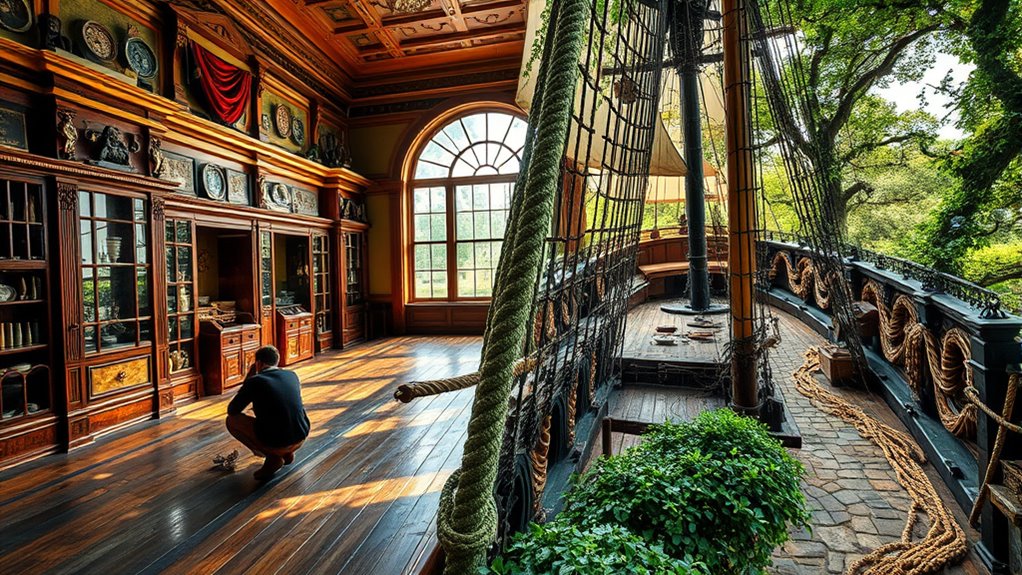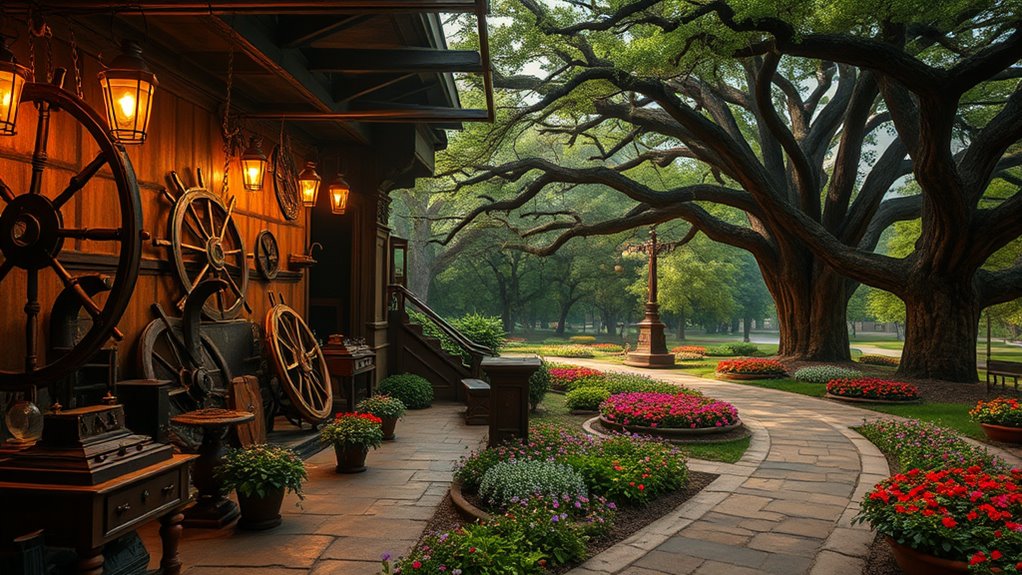Unconventional escape room settings like museums, ships, and parks offer a unique, immersive experience that blends storytelling with environmental design. You can explore ancient artifacts, navigate treacherous waters, or solve outdoor puzzles while feeling truly engaged with the theme. These environments boost creativity and teamwork, making each challenge feel like part of a larger story. Stay tuned—you’ll discover how these creative spaces transform puzzles into unforgettable adventures.
Key Takeaways
- Museums create immersive storytelling experiences by integrating artifact exploration and puzzle-solving within themed environments.
- Ship-themed escape rooms use realistic sounds and décor to simulate maritime adventures, emphasizing navigation and survival challenges.
- Parks and outdoor settings leverage natural landscapes for scavenger hunts and physical tasks, enhancing engagement with the environment.
- Unconventional settings challenge traditional escape room boundaries, fostering creativity and outside-the-box thinking.
- Thematic environmental design in these settings increases immersion, making puzzles feel like parts of a larger, interconnected story.

Escape rooms have become a popular way to challenge your mind and test teamwork, but some venues are pushing the boundaries by offering truly unconventional settings. Imagine stepping into a museum, where every corner offers themed challenges intertwined with immersive storytelling. Instead of the typical four walls, you find yourself exploring ancient artifacts, deciphering clues hidden in exhibits, and piecing together stories from history. Themed challenges transform the space into a living narrative, making you feel like a detective unraveling a mystery buried in time. The immersive storytelling pulls you deeper into the experience, where every puzzle feels like a piece of a larger story, and each new discovery heightens your sense of adventure. Incorporating thematic environmental design enhances realism, making the experience even more engaging.
Venturing onto a ship-themed escape room takes this concept even further. You’re transported to a vessel sailing through treacherous waters, with the ambiance enhanced by realistic sounds of waves and creaking wood. Here, themed challenges revolve around survival tactics, navigation, or deciphering messages from the captain. Every detail, from the ship’s décor to the storyline, immerses you in the seafaring world, making the puzzles more than just tasks—they become part of a daring voyage. The storytelling creates a sense of urgency, pushing you to work together seamlessly, as if you’re truly battling the elements or trying to escape before time runs out.
Parks offer another inventive setting, often transforming open spaces into sprawling puzzle zones. In these outdoor escape rooms, themed challenges might include scavenger hunts that involve nature-based riddles or physical tasks set amid trees and gardens. The immersive storytelling here leverages the environment, making you feel like an explorer on a quest or a detective solving a mystery in the wilderness. The fresh air and natural surroundings heighten the experience, blending adventure with the thrill of discovery. These unconventional locations encourage creative problem-solving, pushing you to think outside the box while embracing the outdoor elements.
Frequently Asked Questions
How Do Safety Protocols Differ in Museum-Based Escape Rooms?
In museum-based escape rooms, safety protocols focus on theft prevention and emergency procedures. You’re encouraged to handle exhibits carefully, avoiding damage, and staff monitor for theft risks. Emergency procedures are clearly communicated, including evacuation routes and first aid locations. You’re expected to follow staff instructions promptly, especially during emergencies, ensuring everyone’s safety while respecting the museum’s valuable collections. These protocols balance fun with the importance of safeguarding both participants and artifacts.
What Are the Logistical Challenges of Setting up Ship-Themed Escape Rooms?
Setting up a ship-themed escape room feels like steering an ocean of logistical chaos. You’ll face huge challenges with themed decor, ensuring it’s both realistic and safe, and managing equipment logistics, like waterproof props and maritime gear. Transporting bulky items and installing them securely on a vessel or dock requires meticulous planning. You must also consider safety regulations, making sure all elements are seaworthy and accessible, or risk sinking your entire project.
How Do Park Environments Affect Game Design and Player Experience?
When designing escape rooms in park environments, you need to contemplate natural lighting and ambient sounds, as they heavily influence player immersion. You might adjust game puzzles to sync with daylight or incorporate soundscapes that enhance the theme. You also have to account for weather changes and outdoor distractions, ensuring your game remains engaging and seamless regardless of environmental factors. This creates a more dynamic, memorable experience for players.
Are There Unique Storytelling Techniques Used in Unconventional Escape Rooms?
In unconventional escape rooms, you’ll find unique storytelling techniques that leverage interactive narratives to deepen immersion. You might experience layered stories, where your choices influence the outcome, or discover environmental storytelling that uses the setting itself to reveal plot points. These techniques keep you engaged, making the experience more dynamic and memorable. By blending immersive storytelling with creative puzzles, these escape rooms create a mesmerizing adventure that feels both personal and extraordinary.
What Permits or Permissions Are Needed for Outdoor or Public Space Escape Rooms?
You’ll need to obtain permits or permissions from local authorities before setting up outdoor or public space escape rooms. Ensuring legal compliance is essential, so check zoning laws, safety regulations, and public gathering rules. Additionally, secure appropriate insurance requirements to protect yourself and participants. Contact city officials or property owners early to streamline the approval process, and always follow local guidelines to run a safe, compliant experience.
Conclusion
As you step into these unexpected venues—museums, ships, parks—you feel the thrill intensify. Every corner hides a clue, every shadow whispers secrets. The familiar transforms into the unknown, pulling you deeper into the mystery. With each passing moment, the line between reality and illusion blurs. Will you reveal the final secret before time runs out? The adventure lingers in your mind, leaving you breathless, enthusiastic to uncover what’s truly hidden just beyond the surface.









